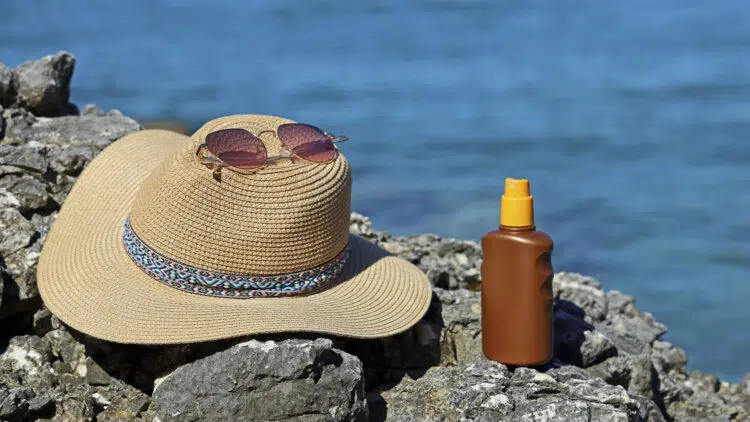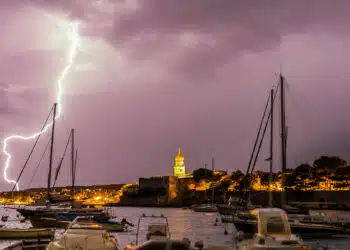Summer, sun, sailing – that means sparkling water, bright blue sky and maybe a gentle breeze. Perfect conditions for summer cruising. But beware: the reflection of the water intensifies the sun’s UV rays, making them about 20 percent more intense. SeaHelp has compiled 10 tips for proper sun protection on the water.
Tip 1
Shade!
In the blazing (midday) sun, the skin burns faster than under the shady bimini or awning, plus it is a few degrees cooler. If no shady spot can be found on board, hats or caps help to keep the head shaded. In addition to being pleasantly cool, staying in the shade is also much healthier than spending a long time in the blazing sun. Every exposure to UV radiation damages the skin and is stored in the body on a so-called “UV lifetime account”. The negative consequences of intensive UV exposure can manifest themselves in a few years, for example, as skin cancer. (Related: Tips against heat: completely relaxed through the hottest days of the year)
Tip 2
UV-protective clothing
Instead of airy cotton T-shirt or bikini and swim trunks, breathable clothing with integrated UV protection reliably protects against sunburn. The UV rays do not stop at plain cotton, but urgently through the fabric to the skin. The protection factor for clothing is called UPF (UV Protection Factor) and works in exactly the same way as for sunscreens or sprays: If you choose factor 10, you can stay in the sun ten times longer than unprotected, etc. However, it depends decisively on the skin type how long you can stay unprotected in the sun at all.
Tip 3
Sun cream with the highest protection
At sea it may be with pleasure also protection factor 50, in order to protect the skin against the UVA and B rays. It takes about 30 minutes for the sunscreen to take full effect, so it’s better to apply it before you set sail or weigh anchor. To avoid harming the environment too much, use a waterproof sunscreen that is gentle on water and the environment without octocrylene and microplastics. By the way: You can still get a sunburn in or under water, one meter below the water surface about 50 percent of the UVB rays still reach the skin. Through contact with water, the effect of the sunscreen products wears off, so that after drying off, you have to reapply your sunscreen.
Tip 4
Sunglasses with UV protection
Not all sunglasses are the same. It is crucial that the glasses have a broadband UV-400 filter, which thus blocks all UVA,-B and C rays – especially cheap sunglasses often do not meet these important criteria. In addition, the glasses should close well on the sides and thus additionally protect the eyes. Sports glasses, which are often used by cyclists, are also very suitable for water sports enthusiasts. To prevent the glasses from slipping due to sweat and movement, an elastic, lightweight goggle strap helps. This also prevents the good piece from going overboard in an inconsiderate moment or during maneuvers.
Tip 5
Take on instead of off
Especially pale, untanned skin must be protected from the unaccustomed strong sunlight. Even with a strong sunscreen, there is a risk of sunburn. If the skin feels warm and heated, better to put on a protective layer of UV clothing.
Tip 6
Protect lips especially
A special sun care stick protects against sunburn on the lips and excessive drying of the sensitive lip area. Especially important for those who are prone to herpes blisters. The better the lips are cared for, the less chance the virus has to develop.
Tip 7
Cream against sunburn
If it happens nevertheless that a part of the skin is angeknuspert (and be it that one forgot to cream a small spot) helps beside a cooling Apres Sun Lotion a cream against burns, which in the on-board pharmacy should not be missing. In addition, the damaged skin must be protected from further sun exposure and should not be exposed to the sun in the following days without protective clothing.
Tip 8
Sun protection for the hair
Sun, wind and salt water put a lot of stress on hair. Especially long and colored hair suffer, bleach, become brittle and develop split ends. To protect the hair, there are special care products that protect against dehydration and help maintain color. In addition, hair also does better if it is exposed to direct sunlight as little as possible: A cap or, in the case of longer hair, a pin-up hairstyle such as a chignon help to protect the hair.
If you have thinning hair, you need to think about sun protection for your sensitive scalp. In addition to a head covering, a transparent, non-greasy sun spray provides UV protection.
Tip 9
Protect your sails
Sails also suffer from the aggressive UV light and become brittle. If the mainsail is not furled into the mast, a fully closing boom cover will help to protect the mainsail from the rays. For the headsail, a furling sleeve is recommended, which is pulled over the sail at the halyard and closed with a zipper. Alternatively, a sewn-on UV double on the parts of the sail that are exposed to the sun when furled provides protection. So does a so-called “color brush,” a special paint that acts like suntan lotion for the sails. If the ship is not sailed for a long period of time, the furling genoa, if it does not have its own tarpaulin, should be removed so that the sail lasts as long as possible.
Tip 10
Hidden UV radiation
Even when the sky is overcast, about 80 percent of UV rays still penetrate cloud cover. To avoid unpleasant sunburns after a supposedly relaxed, cloudy day at sea, the following applies: Always apply sunscreen – regardless of the temperature!














